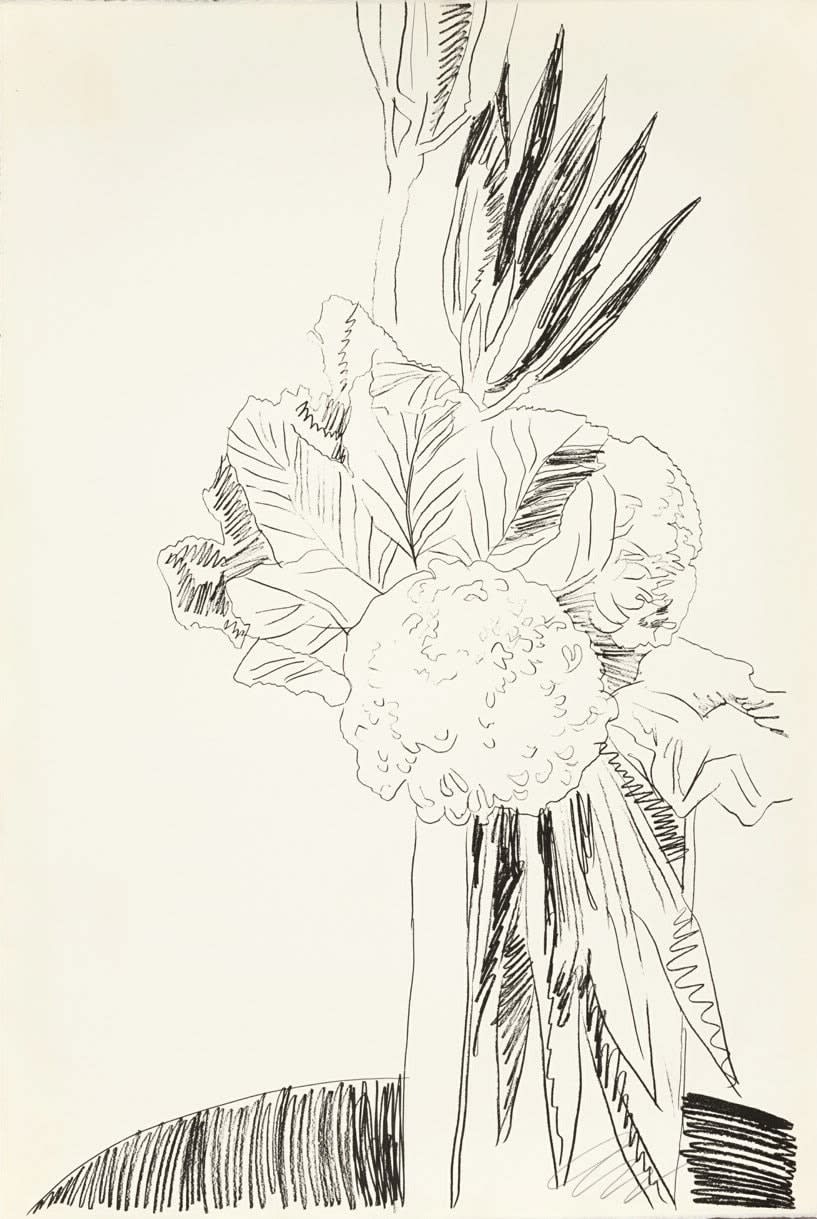
Andy Warhol
Signed and numbered in pencil on verso, initialled in pencil lower right.
101.6 x 68.6 cm
Flowers (Black and White) (FS.II 100) is part of a portfolio of ten screenprints created by Andy Warhol in 1974, based on floral illustrations sourced from a commercial wallpaper catalogue titled Interpretive Flower Designs. That year, Warhol released two parallel portfolios: Flowers (Black and White) and Flowers (Hand-Colored). Both series use the same set of floral motifs, but their visual treatment diverges significantly. While the hand-colored works are enhanced with vibrant, individually applied pigment, the black and white versions are presented in monochrome—inviting a focus on line, form, and composition.
These prints reflect a distinctly hand-drawn aesthetic, reminiscent of Warhol’s early commercial work in the 1950s, where his delicate linework and personal touch were central to his style. In Flowers (Black and White), Warhol deliberately emphasizes the expressive quality of the drawing itself, offering a more intimate and contemplative interpretation of a subject he returned to frequently throughout his career.
Floral imagery is a recurring motif in Warhol’s body of work, appearing in many forms—from decorative drawings and paintings to his well-known 1960s Flowers series based on magazine photographs of hibiscus blooms. While those earlier works are known for their bold color fields and mechanical repetition, Flowers (Black and White) (FS.II 100) presents a quieter, more nuanced perspective.
Here, Warhol trades in bright hues and high-contrast silkscreening for subtle linework and tonal restraint. The black and white composition feels delicate and organic, allowing the viewer to engage directly with the shape and structure of the flowers. The absence of color removes the distraction of surface polish, instead highlighting Warhol’s ability to balance repetition with refinement.
This hand-drawn sensibility is a notable departure from the bold, impersonal aesthetic that defines much of his Pop Art. In contrast to his celebrity portraits and consumer icons—works that often mask the artist’s presence with slick production and mass media references—Flowers (Black and White) (FS.II 100) reveals a softer, more personal dimension of Warhol’s practice.
One of the defining features of Flowers (Black and White) is its embrace of imperfection. The floral outlines are intentionally uneven, at times sketch-like, capturing the spontaneity of the artist’s gesture. Unlike Warhol’s screenprints that use photographic sources with thick, machine-like outlines and saturated inks, this work favors immediacy and subtlety.
Flowers (Black and White) (FS.II 100) thus challenges the viewer to reassess Warhol’s legacy—not just as a pioneer of Pop Art, but as an artist who consistently explored the balance between personal expression and mechanical reproduction. These prints serve as a rare reminder of Warhol’s roots in drawing and his capacity for restraint and delicacy in a medium more often associated with boldness and repetition.
Andy Warhol’s Flowers (Black and White) (FS.II 100) occupies a distinctive space within his broader oeuvre. By returning to the simplicity of line and the intimacy of hand-drawn imagery, Warhol offers a reinterpretation of one of his most enduring subjects. This print captures a quieter moment in his career—one that emphasizes composition over spectacle, gesture over perfection.
In doing so, Warhol reveals the depth and diversity of his artistic vision, demonstrating that his mastery extended far beyond celebrity and consumer culture. With Flowers (Black and White), he invites us to consider beauty in restraint, and to rediscover the expressive potential of the simplest elements: line, form, and the delicate contours of nature.
For more information on Andy Warhol's Flowers (Black and White) (FS. II 100) for sale or to buy Flowers (Black and White) (FS. II 100) contact our galleries using the form below.